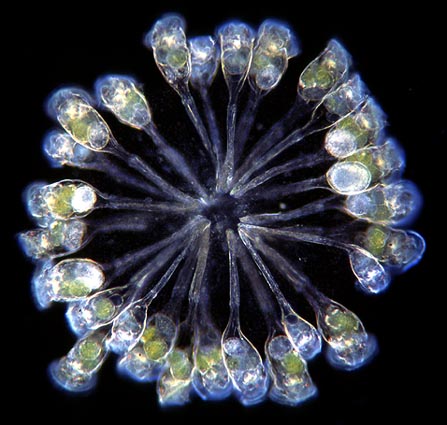
| CONOCHILUS a colony of rotifers |
|
by Wim van Egmond |
|
A tiny sphere is slowly revolving through the water. With their feet stuck together in a small mass of jelly, a group of rotifers form a spinning colony. Rotifers (or wheel animalcules) are one of the smallest animals. They are multicellular but are as big as many protozoa. The smallest being less than 50 microns in length. I found the one millimetre wide colony when I studied a sample taken from the Dutch fens. The first peek through the stereo microscope (which I use to have a good overview of the sample) was a direct hit. The colony I found was Conochilus unicornis. There is a larger species, Conochilus hippocrepis, which has up to a hundred individuals that form a colony easily visible with the naked eye. When I studied them under the light microscope all details that are distinct in rotifers became visible. The crown of cilia they use for feeding as well as for locomotion. The little eyespots (two in this species), the feeding apparatus containing the jaw-like 'trophi'. Because the creatures are so transparent all these details are easy to see. |
An adult and youngster of Conochilus unicornis, photographed with a 25X obj. showing the various internal organs. |
|
| This picture shows many of the individuals carrying eggs. After development the young individuals will join the colony or leave to start a new colony. |
Comments to the author Wim van Egmond are welcomed.
or visit Wim's Home page
© Wim van Egmond 1998
Published in September 1998 Micscape Magazine.
Please report any Web problems
or offer general comments to the Micscape Editor,
via the contact on current Micscape Index.
Micscape is the on-line monthly
magazine of the Microscopy UK web
site at Microscopy-UK